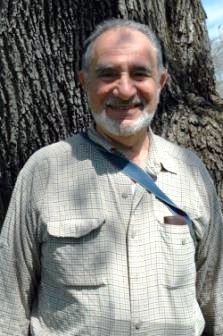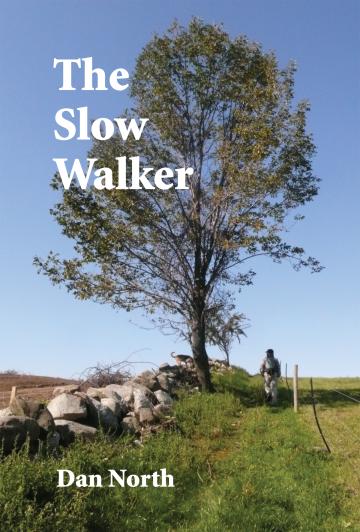KGB Interview: Dan North
I recently had the opportunity to connect with Dan North, a man who is a natural paragon for environmentalists, as well as being an accomplished writer and published author. Dan's new book, The Slow Walker, is a series of short essays capturing what he sees, senses and feels during his regular hikes in the Hudson River Valley.
Through Dan, we are invited into a surviving natural world, be it flocks of geese flying south for the winter, a mallard or wood duck hidden in marshland, or an inviting panoramic view of a mountain lake. Dan brings the kaleidoscope of nature's finely-tuned looking glass into focus to show us what often goes unseen and unappreciated, using metaphor and poetic language to heighten the reader's experience and perception of the moment (“High blueberry bushes covered with white blossoms resembling tiny Tiffany lampshades.” )
And always there is wisdom in Dan's prose, a message to value nature, to teach us about life, for example: “Moss and ferns cling to vertical granite faces rising from the pool. Small hemlocks thrust from upper cracks in the granite walls. Rushing between the cloven rocks, the tumbling water never stops. Why the hurry, I wonder?”
Overall, The Slow Walker is as dedicated, passionate and astute as any nature guide available today, a book that will take you on breathtaking hikes and bring you home, safe, inspired and enlightened.
CCR: After an inspirational plethora of “daytripping” through The Slow Walker, I'm drawn into where you are at any given moment. In passages from your book you use vivid imagery to describe scenes, such as “a pewee on a dead branch preening itself, liquid bending notes from the bird's right...” With such exacting imagery and brush-stroking of details are you an avid note taker on your walks, or is it all from such a keen, outdoorsman, memory as it shows so richly in your works?
DN: I've learned that even though I may think I can remember my observations, thoughts and feelings long enough to get them intact from the woods to the computer, I can't. Memory fades. Details get confused. Feelings become muted. Ideas evaporate. So I carry a ballpoint pen and a three-by-five-inch memo pad with me every time I take a walk. If something appeals to me, I stop and write it down while it is fresh and right in front of me. As a former newspaper reporter, I know that the more thorough my notes are, the better my story will be.
Details make a difference in the feel and texture of a written work. Also, facts are important. I want my notes to specify "shagbark hickory" or "golden crowned kinglet" if that's the case. "Hickory" or "kinglet" would be too vague and "pignut hickory" or "ruby crowned kinglet" would be wrong. Error in such details erodes one of the successful writer's indispensable assets - the reader's trust. And a full description adds depth and immediacy. Some writers with better imagination or memory may be able to create a you-are-there feeling without notes. I can't, and so I rely heavily on my notes.
CCR: I'm an avid outdoors enthusiast as well, from ice fishing to trail map day tripping in the Adirondacks, or just patiently waiting to see my favorite red-tailed hawks that you speak of in your book. Other than “The Sibley Guide to Bird Life & Behavior” that you mention in your book as a reference to assist people in better understanding birdlife, what other reference books can you recommend to budding “naturalists.”
DN: I usually carry Peterson's "A Field Guide to the Birds" with me in the woods. That and a good pair of binoculars are the basics for bird identification. At home, I like the afore-mentioned Sibley guide and "The Birder's Handbook" by Paul Ehrlich, David Dobkin and Darryl Wheye for insights into what birds are doing and why. To know what birds are around and where, the Internet has good sites like eBirds and New York State Department of Environmental Conservation's weekly Hudson Almanac.
The Peterson field guide series is useful for wildflowers, mammals, insects, trees and so on. There are lots of mushroom guides, but you want to be especially careful in this area. They say there are old mushroomers, and bold mushroomers, but no old, bold mushroomers. I'd recommend going with an experienced person before eating anything I picked. One way to do this is through the weekly summer and fall outings of the New York Mycological Society.
CCR: In the chapter, “Blankets of Peace,” you pull the reader into a cerebrally unconscious realm of a full sensory perception filled experience, painting the picturesque views and heightening of our senses. In this day and age with the stressors, pressures and anxieties of this world, I'm compelled to state that it was therapeutic to join you in “an activity to banish the voice of an indifferent world that seemed too big for me,” or “both of us.” My question is do you seek nature as a healthy escape from the rigors of other environments?” And what would you tell beginners interested in nature to assist them into a mindful place when heading for the trail?
DN: We all have somewhere within us what we need to respond to nature. How to activate that response varies with our experience and tastes. For instance, some people charge about and get what they need through something akin to a runner's high. Others do the opposite - the stiller they get the more they experience. In my case, I go to the woods for a feeling of connection with something larger than myself - the interwoven and infinite processes of a magnificent universe that we're all tiny parts of. This feeling might come through watching crows harass a red-tailed hawk, seeing an unexpected killdeer on a warm January mudflat or finding a fresh patch of black trumpet mushrooms.
It can happen anywhere, but for me, the more I get outdoors the better. I can't make it happen, but I can put myself in situations where the connection I want is more likely to happen.
Knowledge helps. I'm more likely to see a shooting star if I go outdoors in the deep country night during August's Perseid shower than if I stand under a streetlamp in July.
Privacy helps. I like to walk outdoors alone or with someone who doesn't talk a lot. I hear enough voices during my regular life. I want to hear birdsong and rustling leaves when I'm in the woods.
Beauty helps. I'm moved by certain hilltops, pastures, ponds and brooks. I return to them again and again to see them in their endless variety of moods.
Patience helps. I have certain rocks or fallen logs where I like to sit and let my surroundings sink in. I treasure the transitions from disjointed everyday busy-busy thoughts to a calmer more reflective mood.
Inevitably, as I become more receptive, doorways open. I like the story about the Japanese emperor seeking an heir to his throne. The emperor interviewed three samurai, asking how they would get a cuckoo to sing. The first said, "If the cuckoo does not sing, I will kill it." The second said, "If the cuckoo doesn't sing, I will ask it to sing."
The third and successful samurai said, "If the cuckoo doesn't sing, I will wait."
CCR: In The Slow Walker each essay has an astute array of metaphors, colors, finite senses heightened to a natural euphoria, as well as subtle ebbs and flows which bring us full circle in experiencing what you are experiencing on your walks. Are these essays the highlights of your “walking year” – that is, are they the apex of your experience, or do you regularly feel enjoy this type of sensory overload, so to speak, on all your hikes.
DN: Some days I can't shake loose from the daily hubbub in my mind: shopping lists, my next school lecture, do I want to accept someone's dinner invitation, is it time to do the laundry. I'll walk for an hour or two, numb to my surroundings. Other days I'm open and receptive. My senses are keen and I'm exhilarated by new impressions and story ideas. Since I don't seem to be able to summon up a creative mood at will, I've come to accept whatever state of mind I'm in at the moment. Moods come and go, and things seem to even out in the end.
 Dan North is a retired journalist living in Jersey City, New Jersey. For those who might want to buy a copy of The Slow Walker, send a check for $10 to Dan North, 128 Sussex St., Jersey City, N.J. 07302. All proceeds go to the Putnam Highlands Audubon Society Marty McGuire Scholarship Fund.
Dan North is a retired journalist living in Jersey City, New Jersey. For those who might want to buy a copy of The Slow Walker, send a check for $10 to Dan North, 128 Sussex St., Jersey City, N.J. 07302. All proceeds go to the Putnam Highlands Audubon Society Marty McGuire Scholarship Fund.
